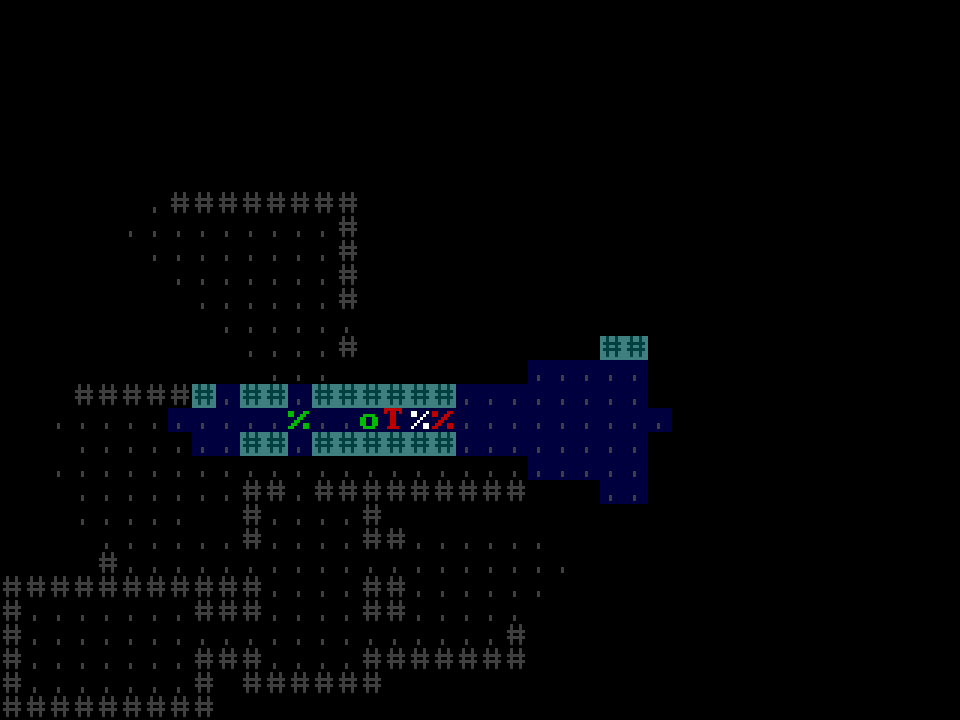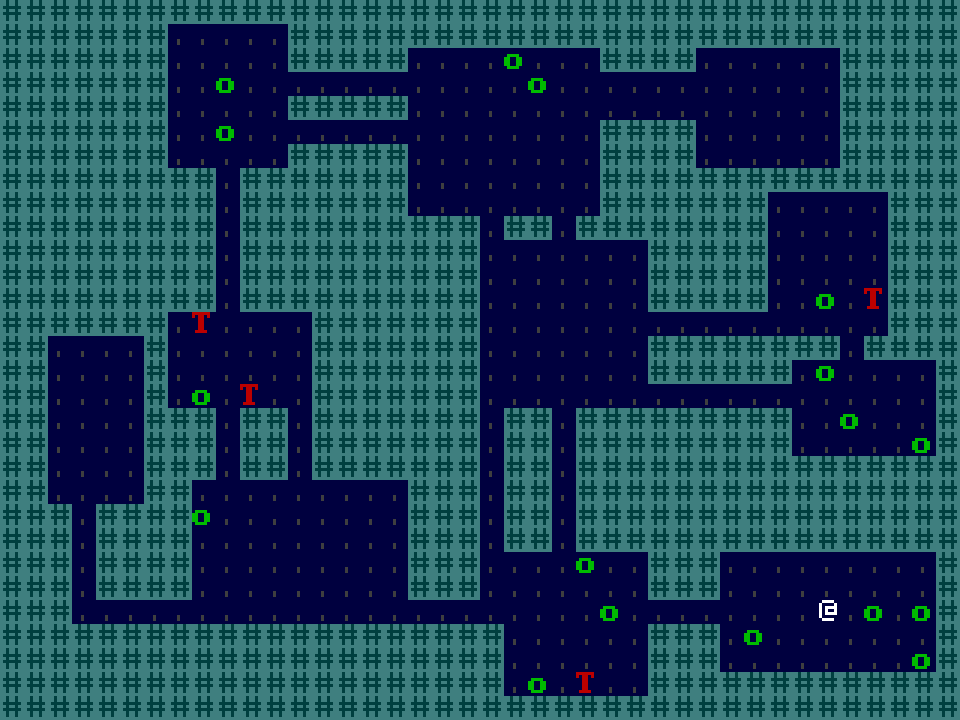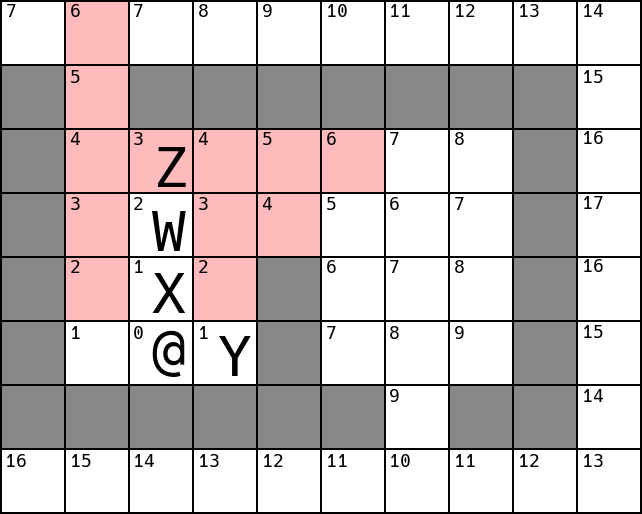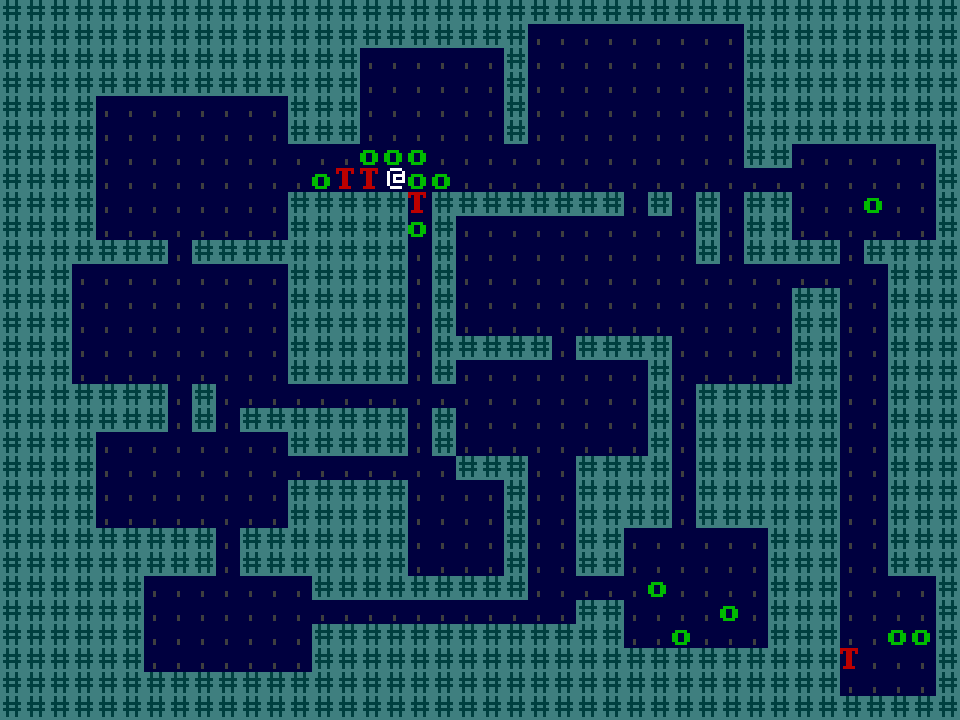Part 6 - AI and Combat
In this part we’ll imbue NPCs with artificial intelligence, and make it possible for them to deal and receive damage.
By the end of this part, the game will look like this:

This part is loosely based on this part of the python tcod tutorial.
Reference implementation branch for starting point: part-5-end
In this post:
- Command-Line Options for Debugging
- NPC Pathfinding
- NPC Line of Sight
- NPC Memory
- Combat
- Hide Previously-seen NPCs
Command-Line Options for Debugging
Before adding AI to the game, let’s make it easier to test. Once NPCs can move on their own, it will be useful to have a way to let NPCs take their turns without needing to move the player. To this end, we’ll add a “wait” command, triggered by the space bar:
// game.rs
...
impl GameState {
...
pub fn wait_player(&mut self) {
self.ai_turn();
}
}
// app.rs
...
impl AppData {
...
fn handle_input(&mut self, input: Input) {
match input {
Input::Keyboard(key) => match key {
...
KeyboardInput::Char(' ') => self.game_state.wait_player(),
_ => (),
},
_ => (),
}
...
}
}
The dungeon is procedurally generated. If we spot some unexpected behaviour which is dependent on a particular level layout, it would be useful if we could rerun the game with the same level. We’ll seed the RNG with a randomly-chosen integer, and print this integer out when the game starts. Then, we’ll add a command-line argument that lets us specify and RNG seed to use instead.
We’ll add one more command-line argument which tells the game to run in “omniscient mode”, where the entire map is always visible. This will let us investigate the behaviour of NPCs which are out of the player’s field of view.
With these 2 changes in place, we’ll be able to run the game with:
cargo run -- --debug-omniscient
…and see:
RNG Seed: 820464076793322760
…on its standard output (for example). When I run this I get a level that looks like:

Now I can rerun the game with the command:
cargo run -- --debug-omniscient --rng-seed=820464076793322760
…and the level will be the same, as it was generated with the same RNG seed. This will help debug any issues by reproducing the circumstances under which they arose.
Here’s the code for adding both the RNG seed argument, and omniscient mode.
Add a VisibilityAlgorithm type, and an argument to VisibilityGrid::update for choosing which algorithm to use.
In the Omniscient case, just mark every cell as visible.
// visibility.rs
...
#[derive(Clone, Copy, Debug)]
pub enum VisibilityAlgorithm {
Shadowcast,
Omniscient,
}
...
impl VisibilityGrid {
pub fn update(
&mut self,
player_coord: Coord,
world: &World,
shadowcast_context: &mut shadowcast::Context<u8>,
algorithm: VisibilityAlgorithm,
) {
self.count += 1;
match algorithm {
VisibilityAlgorithm::Omniscient => {
for cell in self.grid.iter_mut() {
cell.last_seen = self.count;
}
}
VisibilityAlgorithm::Shadowcast => {
let count = self.count;
let grid = &mut self.grid;
shadowcast_context.for_each_visible(
player_coord,
&Visibility,
world,
VISION_DISTANCE,
255,
|coord, _visible_directions, _visibility| {
let cell = grid.get_checked_mut(coord);
cell.last_seen = count;
},
);
}
}
}
}
Two changes in game.rs. Pass the visibility algorithm through to self.visibility_grid.update,
and take an rng_seed in the constructor, which is used to initialize the Isaac64Rng instead
of initializing it with Isaac64Rng::from_entropy.
// game.rs
...
use crate::visibility::{CellVisibility, VisibilityAlgorithm, VisibilityGrid};
...
impl GameState {
pub fn new(
screen_size: Size,
rng_seed: u64,
initial_visibility_algorithm: VisibilityAlgorithm,
) -> Self {
...
let mut rng = Isaac64Rng::seed_from_u64(rng_seed);
...
game_state.update_visibility(initial_visibility_algorithm);
...
}
...
pub fn update_visibility(&mut self, visibility_algorithm: VisibilityAlgorithm) {
let player_coord = self
.world
.spatial_table
.coord_of(self.player_entity)
.unwrap();
self.visibility_grid.update(
player_coord,
&self.world,
&mut self.shadowcast_context,
visibility_algorithm,
);
}
}
In app.rs, just pass the new arguments down to GameState’s methods, and store the visibility algorithm in a field of AppData:
// app.rs
...
use crate::visibility::{CellVisibility, VisibilityAlgorithm};
...
struct AppData {
game_state: GameState,
visibility_algorithm: VisibilityAlgorithm,
}
impl AppData {
fn new(screen_size: Size, rng_seed: u64, visibility_algorithm: VisibilityAlgorithm) -> Self {
Self {
game_state: GameState::new(screen_size, rng_seed, visibility_algorithm),
visibility_algorithm,
}
}
fn handle_input(&mut self, input: Input) {
...
self.game_state.update_visibility(self.visibility_algorithm);
}
}
...
impl App {
pub fn new(
screen_size: Size,
rng_seed: u64,
visibility_algorithm: VisibilityAlgorithm,
) -> Self {
Self {
data: AppData::new(screen_size, rng_seed, visibility_algorithm),
view: AppView::new(),
}
}
}
...
These examples will use the crate meap to parse arguments.
# Cargo.toml
...
[dependencies]
meap = "0.4"
Update main.rs to parse command line arguments and pass the visibility algorithm and RNG seed to App::new:
// main.rs
...
use meap;
...
struct Args {
rng_seed: u64,
visibility_algorithm: VisibilityAlgorithm,
}
impl Args {
fn parser() -> impl meap::Parser<Item = Self> {
meap::let_map! {
let {
rng_seed = opt_opt::<u64, _>("INT", 'r').name("rng-seed").desc("seed for random number generator")
.with_default_lazy("randomly chosen seed", || rand::thread_rng().gen());
visibility_algorithm = flag("debug-omniscient").some_if(VisibilityAlgorithm::Omniscient)
.with_default_general(VisibilityAlgorithm::Shadowcast);
} in {
Self { rng_seed, visibility_algorithm }
}
}
}
}
fn main() {
use meap::Parser;
let Args {
rng_seed,
visibility_algorithm,
} = Args::parser().with_help_default().parse_env_or_exit();
println!("RNG Seed: {}", rng_seed);
...
let app = App::new(screen_size, rng_seed, visibility_algorithm);
...
}
If you used the simon library for argument parsing, the with_help_default() method called above allows you to pass a --help
argument to see usage instructions:
$ cargo run -- --help
Usage: target/debug/chargrid-roguelike-tutorial-2020 [OPTIONS]
Options:
[-r, --rng-seed INT] seed for random number generator (Default: randomly chosen seed)
[--debug-omniscient]
[-h, --help] print help message
Reference implementation branch: part-6.0
NPC Pathfinding
Let’s add some rudimentary AI to NPCs. In order for pathfinding to work, we’ll need a way of finding out which areas
of the map can be traversed by an NPC. Add the following to world.rs:
// world.rs
...
impl World {
...
pub fn can_npc_enter_ignoring_other_npcs(&self, coord: Coord) -> bool {
self.spatial_table
.layers_at(coord)
.map(|layers| layers.feature.is_none())
.unwrap_or(false)
}
pub fn can_npc_enter(&self, coord: Coord) -> bool {
self.spatial_table
.layers_at(coord)
.map(|layers| {
let contains_npc = layers
.character
.map(|entity| self.components.npc_type.contains(entity))
.unwrap_or(false);
let contains_feature = layers.feature.is_some();
!(contains_npc || contains_feature)
})
.unwrap_or(false)
}
}
NPCs can enter a cell if it doesn’t contain a feature or another NPC. It will also turn out convenient to be able to check whether an NPC can enter a cell, ignoring the rule about NPCs not being able to walk on top of each other.
To help with pathfinding, expose one more method in World that returns the coordinate of an entity:
// world.rs
impl World {
...
pub fn entity_coord(&self, entity: Entity) -> Option<Coord> {
self.spatial_table.coord_of(entity)
}
}
While you’re here, remove the npc_type method from World. We won’t be needing it anymore.
To do the heavy lifting of pathfinding, we’ll use a library:
# Cargo.toml
...
[dependencies]
grid_search_cardinal = "0.3"
The general idea for pathfinding is the following: Each time the player moves, populate a grid (called a “distance map”) with the distance from each NPC-traversable cell to the player. On an NPC’s turn, it will consider its local region of this grid, and move in the direction which minimises its distance to the player. Note that an NPC may look further than 1 cell away when deciding which direction to move, and thus make a decision to step into a cell which increases its distance from the player on the way to a cell which is nearer to the player.

The diagram above shows a grid where each floor cell is annotated with its distance from the player. The grey cells are walls, and thus have no distance annotation. The @ represents the player, and W,X,Y,Z represent NPCs. The red-shaded area is all the traversable cells within 3 cells of Z. On its turn, Z will move along a path on the way to one of cells which are 2 away from the player. The first step along this path will increase Z’s distance from the player (from 3 to 4).
I’ve written more on the topic of pathfinding on a grid in a previous post.
Make a new file called behaviour.rs:
// behaviour.rs
use crate::world::World;
use coord_2d::{Coord, Size};
use direction::CardinalDirection;
use entity_table::Entity;
use grid_search_cardinal::{
distance_map::{
DistanceMap, PopulateContext as DistanceMapPopulateContext,
SearchContext as DistanceMapSearchContext,
},
CanEnter,
};
pub struct BehaviourContext {
distance_map_to_player: DistanceMap,
distance_map_populate_context: DistanceMapPopulateContext,
distance_map_search_context: DistanceMapSearchContext,
}
impl BehaviourContext {
pub fn new(size: Size) -> Self {
Self {
distance_map_to_player: DistanceMap::new(size),
distance_map_populate_context: DistanceMapPopulateContext::default(),
distance_map_search_context: DistanceMapSearchContext::new(size),
}
}
pub fn update(&mut self, player: Entity, world: &World) {
struct NpcCanEnterIgnoringOtherNpcs<'a> {
world: &'a World,
}
impl<'a> CanEnter for NpcCanEnterIgnoringOtherNpcs<'a> {
fn can_enter(&self, coord: Coord) -> bool {
self.world.can_npc_enter_ignoring_other_npcs(coord)
}
}
let player_coord = world.entity_coord(player).expect("player has no coord");
const MAX_APPROACH_DISTANCE: u32 = 20;
self.distance_map_populate_context.add(player_coord);
self.distance_map_populate_context.populate_approach(
&NpcCanEnterIgnoringOtherNpcs { world },
MAX_APPROACH_DISTANCE,
&mut self.distance_map_to_player,
);
}
}
The BehaviourContext type will contain all the re-usable state required for pathfinding.
The field distance_map_to_player is the grid which will contain the distance from each cell to the player.
The other 2 fields - distance_map_populate_context and distance_map_search_context contain re-usable
state for updating the distances in the distance map, and choosing a path through a distance map, respectively.
The BehaviourContext::update method updates the distance map such that each cell contains the distance to the player.
Note the NpcCanEnterIgnoringOtherNpcs type, which implements the trait grid_search_cardinal::CanEnter.
The grid_search_cardinal library assumes nothing about the representation of the world, and uses
the CanEnter trait to tell it whether a particular cell of the world is traversable.
When populating the distance map, NPC-occupied cells are treated as traversable. This is because all NPCs share
the distance map, and it isn’t re-computed each time an NPC moves (only when the player moves).
Also note the MAX_APPROACH_DISTANCE constant. We won’t populate the entire distance map each time the player moves -
only the area within 20 cells of the player. This is an optimization which limits the time spent populating the distance
map. NPCs more than 20 cells from the player won’t be able to approach the player, but this won’t really affect gameplay.
Now add the following to behaviour.rs:
// behaviour.rs
...
pub enum NpcAction {
Wait,
Move(CardinalDirection),
}
pub struct Agent {}
impl Agent {
pub fn new() -> Self {
Self {}
}
pub fn act(
&mut self,
entity: Entity,
world: &World,
behaviour_context: &mut BehaviourContext,
) -> NpcAction {
struct NpcCanEnter<'a> {
world: &'a World,
}
impl<'a> CanEnter for NpcCanEnter<'a> {
fn can_enter(&self, coord: Coord) -> bool {
self.world.can_npc_enter(coord)
}
}
let npc_coord = world.entity_coord(entity).expect("npc has no coord");
const SEARCH_DISTANCE: u32 = 5;
match behaviour_context.distance_map_search_context.search_first(
&NpcCanEnter { world },
npc_coord,
SEARCH_DISTANCE,
&behaviour_context.distance_map_to_player,
) {
None => NpcAction::Wait,
Some(direction) => NpcAction::Move(direction),
}
}
}
Start by enumerating all the different actions an NPC can take in NpcAction. Define an Agent type which will currently be empty.
The method Agent::act chooses an action for an NPC to take. Note a second implementation of CanEnter here.
Since we’re not actually choosing the direction an NPC will walk (if any), it’s now necessary to account for the fact
that NPCs can’t move through one another, so we should route the current NPC around the other NPCs.
Recall that World::can_npc_enter only considers a cell to be traversable if it contains neither a wall, nor an NPC.
The call to behaviour_context.distance_map_search_context.search_first chooses a direction for the NPC to move.
It will move in the direction of the first step along a path which will take it to the reachable cell nearest to the
player, within SEARCH_DISTANCE of the NPC. The lower SEARCH_DISTANCE, the less inclined an NPC will be to walk around
other NPCs to reach the player.
Add a BehaviourContext to GameState, and update ai_state to be a ComponentTable<Agent> instead of
a ComponentTable<()>.
// game.rs
use crate::behaviour::{Agent, BehaviourContext, NpcAction};
...
pub struct GameState {
...
ai_state: ComponentTable<Agent>,
behaviour_context: BehaviourContext,
}
impl GameState {
pub fn new(
screen_size: Size,
rng_seed: u64,
initial_visibility_algorithm: VisibilityAlgorithm,
) -> Self {
...
let behaviour_context = BehaviourContext::new(screen_size);
let mut game_state = Self {
...
behaviour_context,
};
...
}
...
}
Update GameState::ai_turn to call Agent::act so NPCs actually move on their turns:
...
impl GameState {
...
fn ai_turn(&mut self) {
self.behaviour_context
.update(self.player_entity, &self.world);
for (entity, agent) in self.ai_state.iter_mut() {
let npc_action = agent.act(entity, &self.world, &mut self.behaviour_context);
match npc_action {
NpcAction::Wait => (),
NpcAction::Move(direction) => self.world.maybe_move_character(entity, direction),
}
}
}
}
And update world.rs to return a ComponentTable<Agent> in its Populate struct:
// world
use crate::behaviour::Agent;
...
pub struct Populate {
pub player_entity: Entity,
pub ai_state: ComponentTable<Agent>,
}
...
impl GameState {
pub fn populate<R: Rng>(&mut self, rng: &mut R) -> Populate {
let mut ai_state = ComponentTable::default();
for (coord, &terrain_tile) in terrain.enumerate() {
match terrain_tile {
...
TerrainTile::Npc(npc_type) => {
let entity = self.spawn_npc(coord, npc_type);
self.spawn_floor(coord);
ai_state.insert(entity, Agent::new());
}
}
}
Populate {
player_entity: player_entity.unwrap(),
ai_state,
}
}
}
Don’t forget to add mod behaviour; to main.rs:
...
mod behaviour;
...
Run this with --debug-omniscient and observe pathfinding in action.
Since there’s still no combat system, expect to find yourself trapped in a corner
surrounded by NPCs!

Reference implementation branch: part-6.1
NPC Line of Sight
To make the game more realistic, we’ll require that NPCs must be able to see the player in order to move towards them.
Start by adding a method to World for testing whether an NPC can see through the cell at a given coordinate.
// world.rs
...
impl World {
...
pub fn can_npc_see_through_cell(&self, coord: Coord) -> bool {
self.spatial_table
.layers_at(coord)
.map(|layers| layers.feature.is_none())
.unwrap_or(false)
}
}
Now we could go and run the shadowcast filed-of-view algorithm for each NPC, but that would be expensive. Instead, we only need to test if the (straight) line segment between each NPC and the player can be traversed without visiting a cell which the NPC can’t see through.
To help talk about lines rasterized onto grids, grab a library:
# Cargo.toml
[dependencies]
line_2d = "0.5"
Add a function for testing NPC line of sight to behaviour.rs:
// behaviour.rs
...
use line_2d::LineSegment;
use shadowcast::{vision_distance, VisionDistance};
...
fn npc_has_line_of_sight(src: Coord, dst: Coord, world: &World) -> bool {
const NPC_VISION_DISTANCE_SQUARED: u32 = 100;
const NPC_VISION_DISTANCE: vision_distance::Circle =
vision_distance::Circle::new_squared(NPC_VISION_DISTANCE_SQUARED);
if src == dst {
return true;
}
for coord in LineSegment::new(src, dst).iter() {
let src_to_coord = coord - src;
if !NPC_VISION_DISTANCE.in_range(src_to_coord) {
return false;
}
if !world.can_npc_see_through_cell(coord) {
return false;
}
}
true
}
Add a player: Entity argument to Agent::act, and then call our new function to test whether the NPC can
see the player. For now, just have the NPC wait on their turn if they can’t see the player.
...
impl Agent {
...
pub fn act(
&mut self,
entity: Entity,
player: Entity,
world: &World,
behaviour_context: &mut BehaviourContext,
) -> NpcAction {
...
if !npc_has_line_of_sight(npc_coord, player_coord, world) {
return NpcAction::Wait;
}
...
}
}
Update the call of Agent::act in game.rs to pass the player:
// game.rs
...
impl Game {
...
fn ai_turn(&mut self) {
self.behaviour_context
.update(self.player_entity, &self.world);
for (entity, agent) in self.ai_state.iter_mut() {
let npc_action = agent.act(
entity,
self.player_entity,
&self.world,
&mut self.behaviour_context,
);
match npc_action {
NpcAction::Wait => (),
NpcAction::Move(direction) => self.world.maybe_move_character(entity, direction),
}
}
}
}
Run the game with omniscience and confirm that as soon as there stops being line of sight between you and an NPC following you, the NPC freezes.
Reference implementation branch: part-6.2
NPC Memory
That’s still not super realistic. In real life orcs and trolls would keep following you after you left their line of sight. To simulate NPCs remembering where they last saw you, let’s have NPCs continue to follow you for a couple of turns after losing line of sight. The goal of this section is to demonstrate how the AI of each NPC can be stateful. We could make the state more complicated, to say, have NPCs move to the location where they last saw the player, but that’s out of the scope of this tutorial.
The only state each NPC needs in order to follow the player for a number of turns after losing sight, is a single counter storing the number of turns since the NPC saw the player:
// behaviour.rs
...
pub struct Agent {
turns_since_last_saw_player: u32,
}
...
impl Agent {
pub fn new() -> Self {
Self {
turns_since_last_saw_player: u32::MAX,
}
}
...
}
Update the counter on each NPC’s turn, and use the value in the counter to determine whether the NPC moves on their turn.
...
impl Agent {
...
pub fn act(
&mut self,
entity: Entity,
player: Entity,
world: &World,
behaviour_context: &mut BehaviourContext,
) -> NpcAction {
...
if npc_has_line_of_sight(npc_coord, player_coord, world) {
self.turns_since_last_saw_player = 0;
} else {
self.turns_since_last_saw_player = self.turns_since_last_saw_player.saturating_add(1);
}
const MAX_TURNS_TO_CHASE_PLAYER_AFTER_LOSING_SIGHT: u32 = 3;
if self.turns_since_last_saw_player > MAX_TURNS_TO_CHASE_PLAYER_AFTER_LOSING_SIGHT {
return NpcAction::Wait;
}
...
}
}
Reference implementation branch: part-6.3
Combat
To implement combat, start by defining a HitPoints component, and adding
hit points to the player and NPC entities.
// world.rs
...
#[derive(Clone, Copy, Debug)]
pub struct HitPoints {
pub current: u32,
pub max: u32,
}
impl HitPoints {
fn new_full(max: u32) -> Self {
Self { current: max, max }
}
}
...
entity_table::declare_entity_module! {
components {
tile: Tile,
npc_type: NpcType,
hit_points: HitPoints,
}
}
...
impl World {
...
fn spawn_player(&mut self, coord: Coord) -> Entity {
...
self.components
.hit_points
.insert(entity, HitPoints::new_full(20));
...
}
fn spawn_npc(&mut self, coord: Coord, npc_type: NpcType) -> Entity {
...
let hit_points = match npc_type {
NpcType::Orc => HitPoints::new_full(2),
NpcType::Troll => HitPoints::new_full(6),
};
self.components.hit_points.insert(entity, hit_points);
...
}
...
}
For now we’ll just support bump combat. That is, when a character would move, if the destination of the move is occupied by an enemy of the moving character, instead of moving, an attack occurs.
// world.rs
...
impl World {
...
pub fn maybe_move_character(&mut self, character_entity: Entity, direction: CardinalDirection) {
let character_coord = self
.spatial_table
.coord_of(character_entity)
.expect("character has no coord");
let new_character_coord = character_coord + direction.coord();
if new_character_coord.is_valid(self.spatial_table.grid_size()) {
let dest_layers = self.spatial_table.layers_at_checked(new_character_coord);
if let Some(dest_character_entity) = dest_layers.character {
let character_is_npc = self.components.npc_type.contains(character_entity);
let dest_character_is_npc =
self.components.npc_type.contains(dest_character_entity);
if character_is_npc != dest_character_is_npc {
self.character_bump_attack(dest_character_entity);
}
} else if dest_layers.feature.is_none() {
self.spatial_table
.update_coord(character_entity, new_character_coord)
.unwrap();
}
}
}
fn character_bump_attack(&mut self, victim: Entity) {
const DAMAGE: u32 = 1;
if let Some(hit_points) = self.components.hit_points.get_mut(victim) {
hit_points.current = hit_points.current.saturating_sub(DAMAGE);
if hit_points.current == 0 {
self.character_die(victim);
}
}
}
}
For now, all attacks deal a single point of damage.
The code above contains a call to self.character_die(victim),
which we haven’t implemented yet. Let’s make it so that when a character dies,
it is replaced by a corpse.
Define tile types for corpses, and add a layer to the spatial table for storing corpse location.
// world.rs
...
#[derive(Clone, Copy, Debug)]
pub enum Tile {
...
PlayerCorpse,
NpcCorpse(NpcType),
}
...
spatial_table::declare_layers_module! {
layers {
...
corpse: Corpse,
}
}
Now we can implement the character_die method:
// world.rs
...
impl World {
...
fn character_die(&mut self, entity: Entity) {
if let Some(occpied_by_entity) = self
.spatial_table
.update_layer(entity, Layer::Corpse)
.err()
.map(|e| e.unwrap_occupied_by())
{
// If a character dies on a cell which contains a corpse, remove the existing corpse
// from existence and replace it with the character's corpse.
self.remove_entity(occpied_by_entity);
self.spatial_table
.update_layer(entity, Layer::Corpse)
.unwrap();
}
let current_tile = self.components.tile.get(entity).unwrap();
let corpse_tile = match current_tile {
Tile::Player => Tile::PlayerCorpse,
Tile::Npc(npc_type) => Tile::NpcCorpse(*npc_type),
other => panic!("unexpected tile on character {:?}", other),
};
self.components.tile.insert(entity, corpse_tile);
}
pub fn remove_entity(&mut self, entity: Entity) {
self.components.remove_entity(entity);
self.spatial_table.remove(entity);
self.entity_allocator.free(entity);
}
...
}
Expose a method of World called is_living_character which lets us check whether an
entity refers to a living character:
// world.rs
...
impl World {
...
pub fn is_living_character(&self, entity: Entity) -> bool {
self.spatial_table.layer_of(entity) == Some(Layer::Character)
}
...
}
In game.rs, before all the NPCs take their turn, remove dead NPCs from ai_state:
// game.rs
...
impl GameState {
...
fn ai_turn(&mut self) {
self.behaviour_context
.update(self.player_entity, &self.world);
let dead_entities = self
.ai_state
.entities()
.filter(|&entity| !self.world.is_living_character(entity))
.collect::<Vec<_>>();
for dead_entity in dead_entities {
self.ai_state.remove(dead_entity);
}
for (entity, agent) in self.ai_state.iter_mut() {
...
}
}
}
Note that the call to collect above will allocate if there are any dead characters
to remove from ai_state. This would be easy to optimize away by adding a field
to GameState which gets populated with all dead entities each turn, but it didn’t
seem worth it.
Expose a method is_player_alive:
impl GameState {
...
pub fn is_player_alive(&self) -> bool {
self.world.is_living_character(self.player_entity)
}
}
Now in app.rs there are two things that need to change.
First, prevent the player from moving if they are dead:
// app.rs
impl AppData {
fn handle_input(&mut self, input: Input) {
if !self.game_state.is_player_alive() {
return;
}
match input {
...
}
}
}
Second, update the rendering logic to handle corpse tiles. This is a small refactor which moves common colour definitions into its own module.
// app.rs
...
mod colours {
use rgb24::Rgb24;
pub const PLAYER: Rgb24 = Rgb24::new_grey(255);
pub const ORC: Rgb24 = Rgb24::new(0, 187, 0);
pub const TROLL: Rgb24 = Rgb24::new(187, 0, 0);
}
fn currently_visible_view_cell_of_tile(tile: Tile) -> ViewCell {
match tile {
Tile::Player => ViewCell::new()
.with_character('@')
.with_foreground(colours::PLAYER),
Tile::PlayerCorpse => ViewCell::new()
.with_character('%')
.with_foreground(colours::PLAYER),
Tile::Floor => ViewCell::new()
.with_character('.')
.with_foreground(Rgb24::new_grey(63))
.with_background(Rgb24::new(0, 0, 63)),
Tile::Wall => ViewCell::new()
.with_character('#')
.with_foreground(Rgb24::new(0, 63, 63))
.with_background(Rgb24::new(63, 127, 127)),
Tile::Npc(NpcType::Orc) => ViewCell::new()
.with_character('o')
.with_bold(true)
.with_foreground(colours::ORC),
Tile::Npc(NpcType::Troll) => ViewCell::new()
.with_character('T')
.with_bold(true)
.with_foreground(colours::TROLL),
Tile::NpcCorpse(NpcType::Orc) => ViewCell::new()
.with_character('%')
.with_bold(true)
.with_foreground(colours::ORC),
Tile::NpcCorpse(NpcType::Troll) => ViewCell::new()
.with_character('%')
.with_bold(true)
.with_foreground(colours::TROLL),
}
}
fn previously_visible_view_cell_of_tile(tile: Tile) -> ViewCell {
match tile {
Tile::Player => ViewCell::new()
.with_character('@')
.with_foreground(Rgb24::new_grey(255)),
Tile::PlayerCorpse => ViewCell::new()
.with_character('%')
.with_foreground(Rgb24::new_grey(255)),
Tile::Floor => ViewCell::new()
.with_character('.')
.with_foreground(Rgb24::new_grey(63))
.with_background(Rgb24::new_grey(0)),
Tile::Wall => ViewCell::new()
.with_character('#')
.with_foreground(Rgb24::new_grey(63))
.with_background(Rgb24::new_grey(0)),
Tile::Npc(NpcType::Orc) => ViewCell::new()
.with_character('o')
.with_bold(true)
.with_foreground(Rgb24::new_grey(63)),
Tile::Npc(NpcType::Troll) => ViewCell::new()
.with_character('T')
.with_bold(true)
.with_foreground(Rgb24::new_grey(63)),
Tile::NpcCorpse(NpcType::Orc) => ViewCell::new()
.with_character('%')
.with_foreground(Rgb24::new_grey(63)),
Tile::NpcCorpse(NpcType::Troll) => ViewCell::new()
.with_character('%')
.with_foreground(Rgb24::new_grey(63)),
}
}
Update the depth calculation to account for the new corpse layer:
impl<'a> View<&'a AppData> for AppView {
fn view<F: Frame, C: ColModify>(
&mut self,
data: &'a AppData,
context: ViewContext<C>,
frame: &mut F,
) {
for entity_to_render in data.game_state.entities_to_render() {
let view_cell = ...;
let depth = match entity_to_render.location.layer {
None => -1,
Some(Layer::Floor) => 0,
Some(Layer::Feature) => 1,
Some(Layer::Corpse) => 2,
Some(Layer::Character) => 3,
};
frame.set_cell_relative(entity_to_render.location.coord, depth, view_cell, context);
}
}
}
And that’s it. NPCs and the player can kill one another, and leave behind corpses.
Reference implementation branch: part-6.4
Hide Previously-seen NPCs
Now that NPCs can move around on their own, it’s possible for an NPC which is out of the player’s field of view to move. At the moment, there’s nothing preventing the game from rendering the movements of an NPC which isn’t currently visible (it will still be greyed-out of course). We could have the game keep track of the most-recently-seen contents of each cell, so it could continue to render a moved NPC at its original location. In the interest of simplicity however, let’s just change rendering code so the only previously-visible things we render are walls and floor:
// app.rs
...
fn previously_visible_view_cell_of_tile(tile: Tile) -> ViewCell {
match tile {
Tile::Floor => ViewCell::new()
.with_character('.')
.with_foreground(Rgb24::new_grey(63))
.with_background(Rgb24::new_grey(0)),
Tile::Wall => ViewCell::new()
.with_character('#')
.with_foreground(Rgb24::new_grey(63))
.with_background(Rgb24::new_grey(0)),
_ => ViewCell::new(),
}
}

Reference implementation branch: part-6.5